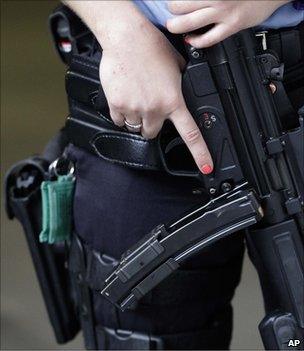Norway attacks: The agony of the rescue
- Published
- comments

Flowers were still being dropped in Lake Tyrifjorden on Tuesday
All day small groups of people come down to the water's edge and look across the sound to the tiny island of Utoeya. The dock is clearly visible. The distance is not much more than 400m (yds). For hundreds of young people this deep channel was their means of escape from a gunman hunting them down.
The closest point to the island is a caravan site and a cove where you can tie up a boat.
Last Friday the people in the camps heard the shooting. Some thought it was fireworks set up at the summer camp. Then they saw the frantic swimming, the cries for help that echoed across the bay.
In the hour and a quarter afterwards, this camp site was the centre of a rescue operation. Holiday-makers scrambled down the cinder path, leapt into their boats and headed towards the island. There may have been 100 people in the water.
Among the first to go out were Bjorn Juvet and his wife Aasa. Because the young people were fleeing a man in police uniform the swimmers were suspicious.
"The first thing," said Aasa, "was that they didn't trust us." Even though they were desperate they held back from climbing into the boat. "Can we trust you?" they shouted again. Aasa told them she was a mother and they came to the boat.
But there were too many in the water. Some were wounded. Some had found life jackets, most had not. Bjorn said it was good to help people but others had to be left in the water. A terrible choice.
The freezing, shivering swimmers were wrapped in blankets. Aasa told them, "Someone has to call the police." But they said they had been making calls but, at first, no one believed them.
No mood to criticise

Questions about the police response should come later, people around Utoeya say
Aasa drove some of them towards the nearest town of Sundvollen. On the way they encountered a police roadblock. The local police were waiting for armed response units to arrive from Oslo. The police officer was a woman in uniform with a gun.
When the young people saw her they screamed and urged Aasa not to stop. They did not know who to trust.
Eventually after an hour the police Swat teams arrived but there was a further delay.
They jumped into a local police boat but it was too small and sprang a leak. They had to commandeer private boats for the short crossing to the island. Having arrived there, the gunman Breivik surrendered in under two minutes.
There had been at least one press helicopter over the island. It managed to take pictures of Breivik surrounded by bodies. The police helicopter was parked some way south of the capital. The Swat teams chose to travel the 40km (25 miles) from the capital by car. It took them just under half an hour.
Many of the rescuers are scarred by what happened. Bjorn said: "I saw things that no one should see."
There are questions about the police response but the local community is in no mood to criticise. Everything is so raw and painful.
What everyone now understands is that Breivik, the gunman, deliberately planted a bomb in the capital knowing it would draw in police and rescue units, giving him the time to massacre young people at a summer camp.